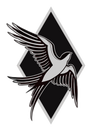THEORY
My intentions were to design a consistent tool that still retained a traditional-esque feel and sound of a coil/relay machine. The positive feel in the skin that a coil machine provides has always been my preference. However, the consistency of a rotary driven machine is difficult to dispute. My patent-pending 2 piece A-bar design provides a give/bog as the needle strikes the skin, much like a coil machine. The “perfect punch” we all are looking for, with all the reliability and efficiency that a rotary driven machine is known for. Spinning exactly the same, every time. That consistency is paired with the ability to dampen/slow down the needle speed as it comes in contact with the skin, before retracting and completing its stroke. This is what makes depositing pigment highly efficient. It essentially slows needle speed down just enough before retraction, giving the needle more time in the skin to do its job. Think about that, more time in the skin depositing pigment most likely results in higher saturation with the least amount of passes. The least amount of trauma inflicted to reach saturation will produce better healing tattoos. I use the “dampening” term to describe this action, but it’s also just as easy to think about the Abar actuation in terms of a suspension circuit; slow or fast, soft or hard. At what speed and force is needed to actuate the Abar is how I usually approach tuning and explaining this give or bog. This Abar action is also directly affected by rubber bands, needle bar tension, pigment viscosity; Anything that would potentially restrict that movement is considered. A stronger spring will require more force to actuate and is a more rigid connection. A more rigid connection will be put back to its start position quicker in comparison to that of a softer connection, because there is no excessive movement in that connection. In other words it doesn’t flex as much as a softer spring. That rigidity directly affects the retraction of the machine to it’s start position(on a rotary driven machine) A coil machine utilizes spring steel for its retraction, where as a rotary driven machine is put back to its start position under the power of the motor. This Abar design enables you to delay that retraction to it’s start position, with an element of tune-ability by way of various spring steel thicknesses **It differs from most conventional/hybrid rotary machines in the sense that this spring directly affects the course of the machine’s stroke in contrast to simply being a connection point.
Bearing US Patent no: 12,144,952
Coil machine feel, with rotary machine consistency.
I look forward to hearing your input on this design and the various effects that can be achieved with this tool.
Thanks for your interest,
NIcky
